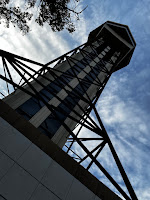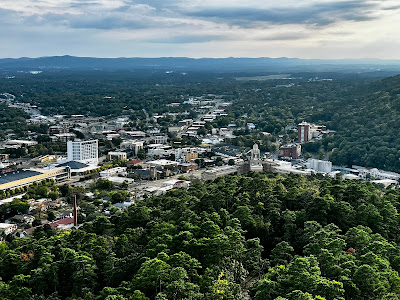Arkansas, the Natural State
Border crossings can signal a change ahead, and crossing the Texas/Arkansas border at Texarkana was a vivid indicator of that. The temperatures got cooler, the roads crossed a hilly landscape covered in trees! Wow, we aren’t in Texas anymore! I thought we would see farmland and cattle ranches in Texas but they seem to be more plentiful in Arkansas!
In planning our 3 month long Adventures on the Road we use an app called Roadtrippers, which helps us with routing, as well as planning things to do and places to see along the way. We had selected several locations to visit including a National Park, yet Arkansas was a new state for us to discover and with much history to learn about. Its natural beauty did not disappoint!
Before we purchased our trailer and we dreamed of traveling on the road, Steve and I were focused on visiting National Parks. We have expanded our destinations to include experiences, tours and museums that help us understand the history and culture of the regions we are traveling through.
During our time exploring Arkansas, I was surprised to learn more of the state’s colorful history from its time as settlements on the frontier in the Indian Territory, to the formation of the Federal U.S. Marshall service, to a popular destination for those seeking a physical cure at its natural hot springs. We saw glimpses of Arkansas history and beauty revealed in brick, stone and sacrifice.
Brick
Hot Springs National Park
Before it was designed as a National Park, Hot Springs was a National Reserve. As such the federal government controlled contracted services provided to the public at the bathhouses at the many springs. At that time the buildings were made of wood, and like many towns they were ravaged and destroyed by fire. Under the control of government regulations the buildings needed to be rebuilt of brick or stone which is what we now experience at Hot Springs National Park.
bathhouses sell services to the public while meeting standards set by the government. Others are maintained in their original state for visitors to tour and explore this bygone era.
In the decades before Penicillin, antibiotics and other medical treatments, the sick and infirm came to places with natural hot springs seeking a cure from the “healing water”. We see this idea that an unusual source of water, such as a spring, can cure the sick even recounted in the Bible in the story of the sick man seeking his healing at a natural spring. Jesus found him there and healed him miraculously!
“Now there is in Jerusalem by the Sheep Gate a pool, which is called in Hebrew, Bethesda, having five porches. In these lay a great multitude of sick people, blind, lame, paralyzed, waiting for the moving of the water. Now a certain man was there who had an infirmity thirty-eight years. When Jesus saw him lying there, and knew that he already had been in that condition a long time, He said to him, “Do you want to be made well?” The sick man answered Him, “Sir, I have no man to put me into the pool when the water is stirred up; but while I am coming, another steps down before me.” Jesus said to him, “Rise, take up your bed and walk.” And immediately the man was made well, took up his bed, and walked. And that day was the Sabbath.”
John 5:2-3, 5-9 NKJV
In Hot Springs those seeking a last-hope cure, stayed in elegant hotels or sanitariums for months long courses of prescribed treatments of soaking or bathing in the hot mineral waters, walking on trails through the woods and hills, and strengthening muscles in well equipped gymnasiums, followed by massage services. This holistic approach to health is prevalent even in our day of “modern medicine”!
Bathhouse Row
Each bath house that was rebuilt after the fires endeavored to bring the most elegance and style to the forefront, to compete for customers.
Remember visitors stayed for months at a time, so the entire area was a boom-town of sorts. Hotels, restaurants and a military hospital line the streets around the springs. Many historic buildings now stand as silent empty guardians of the city. Other buildings are undergoing renovations to restore them to vibrant new life.
Promenade
Walking paths were laid with elegant brick patterns. Visitors in “those olden days” still dressed up for all activities, from their dresses to their footwear, even for walking on a trail, so a paved pathway was preferring to a natural trail as we enjoy today. Our “active wear” fashion mindset today is quite different, with many wearing leisure wear not only for trails and exercise but even to work! Fashion has made quite a turn!
Observation Tower
We took the tower elevator 216 feet up to the observation decks where we enjoyed some breathtaking panoramic views of the Ouachita Mountains, Hot Springs Mountain, and Diamond Lakes area – all at 1,256 feet above sea level.
Stone
Arkansas seems to be located on the tops of massive stone hills, many of which are exposed to view. This is part of the reason there are a lot of springs in the area. The state is also abundant in minerals and crystals.
We broke up a drive day with a tour of the Ron Coleman Crystal Mine. All of the crystal mined here is clear in color.
We started our tour with time to explore some museum quality pieces of gems and minerals from around the world.
We then boarded our truck for a drive through the quarry and past those who pay to dig through the mine tailings searching for the crystals cast off from the mining company.
Sacrifice
US Marshal’s Museum
A long planned, but just recently opened site that outlines the history and scope of service of the US Marshal service, the museum features a unique exterior with a modified star-shaped design signifying the star badge worn by courageous U.S. Marshals.
Set along the banks of the Arkansas River where many deputies in the Old West crossed and forded, the back wall of the museum is all glass to take in the sweeping view!
The first gallery in the museum is dedicated to those who have made the ultimate sacrifice of laying down their life to protect others. There was a piece of I-beam steel from the World Trade Center. (Picture above). US Marshals were among the first responders on scene on 9-11 in NYC because they had offices just across the street from the towers.
Marshals respond to many disaster scenes, riots, protect court room proceedings, and more. During Desegregate of schools and Universities it was the US Marshals who provided safety and order. After the 9-11 attacks the Marshals were tasked with providing safety at airports; TSA and the Witness Protection Program are just two agencies that originated out of the Marshal’s service. The duties of this Federal law enforcement agency have been continuously changing as needs arise!
Fort Smith National Historic Park
Just a mile down the river is the site of Fort Smith. There are actually two forts and a federal court on this site. All that remains of the first fort built in 1817 to keep peace in the Arkansas River Valley between the Osage and Cherokee, is the stone foundation of walls barely visible above the hilly ground.
The second fort was built in 1838. This site became an important supply depot during the US-Mexican War, the California Gold Rush and for surging westward expansion.
In 1872 the Federal Court of the Western District of Arkansas moved into the buildings that were formerly enlisted men’s barracks. Offices for the US Marshals were located in this building. Over the next 24 years hundreds of US Deputy Marshals rode out from the court into Indian Territory to maintain law and order!
Art, Architecture and Nature
This beautiful and quiet retreat is a mix of botanical garden and natural woodland set along the a Lake Hamilton Shoreline.
 It is a peaceful place to enjoy a stroll along shaded pathways and over some picturesque bridges. Although not a lot was in bloom, there were bedding areas skillfully planted throughout the park. It must be very showy in the spring when 130,000 tulip bulbs are in bloom!
It is a peaceful place to enjoy a stroll along shaded pathways and over some picturesque bridges. Although not a lot was in bloom, there were bedding areas skillfully planted throughout the park. It must be very showy in the spring when 130,000 tulip bulbs are in bloom!
Anthony Chapel
On the grounds of the gardens is a chapel set amid the trees. Until the pathway came around a bend we couldn’t even see the two story high chapel, it was almost completely invisible because of its glass and steel design. Because of the elaborate design, it was difficult to discern what was inside and outside!
Such a beautiful and tranquil space to take some time to reflect on the goodness of God!
Crystal Bridges Museum of Modern American Art
Crystal Bridges which opened in 2011, takes its name from a nearby natural spring and the bridge construction incorporated in the building, designed by world-renowned architect Moshe Safdi. A series of pavilions nestled around two spring-fed ponds house galleries, meeting and classroom spaces, and a large, glass-enclosed gathering hall. This is a picture of a scale model of the grounds and buildings.
Located in Bentonville and founded by philanthropist and arts patron Alice Walton, this is a fabulous place to explore American Art.
Here you will see everything from landscapes, to portraiture to contemporary and modern pieces. There are sculptures in the buildings and in the gardens. The architecture itself is so artistic and created such a great experience as we strolled around.
There was also digital and computer generated art. Beeple’s HUMAN ONE embraces both digital video and a three-dimensional sculptural form to present an explorer walking through endlessly transforming landscapes.
In addition to viewing the painting and works of art, this was a fun place to do some people watching! I saw these two groups of people studying each other quite closely!
Soon it was just about time for the museum to close. But there was still more to explore outside on more than five miles of pathways and sculpture gardens!
Frank Lloyd Wright’s Bachman-Wilson Home, was originally built in 1956 in New Jersey. In 2013, when it was threatened with recurring flooding, Crystal Bridges acquired the house. The entire structure was then taken apart and each component was labeled, packed, and shipped cross country to the museum grounds, where it was reconstructed in 2015.
The Bachman-Wilson House contains a distinct mid-century modern design, full of sleek mahogany wood which allows the house to flow with Frank Lloyd Wright’s tell-tale elongated layout, epitomizing the connection between art, architecture and nature. That same connection, by the way, is also so evident in the American Art curated in a fabulous series of buildings set in the midst of the Ozark forest at Crystal Bridges!













































No comments:
Post a Comment